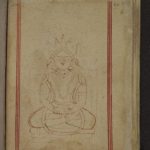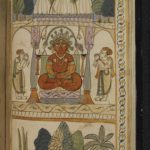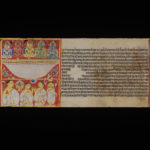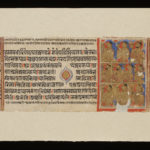Article: Candraprabha
Candraprabhanātha or Lord Candraprabha is also known as Candraprabha-svāmī and Candraprabhu-svāmī. He is the eighth of the 24 Jinas of the present cycle of time. The word Jina means ‘victor’ in Sanskrit. A Jina is an enlightened human being who has triumphed over karma through practising extreme asceticism and teaches the way to achieve liberation. A Jina is also called a Tīrthaṃkara or ‘ford-maker’ in Sanskrit – that is, one who has founded a community after reaching omniscience.
Candraprabha is not an historical figure. He is not singled out for individual biographies in the Śvetāmbara canonical scriptures. Treated like most of the other Jinas, he is provided only with basic biographical information. This information is fairly standardised and remains identical throughout later sources except for occasional variations, or confusions, in numbers.
The meaning of his name is straightforward, a feature not shared by all the Jinas’ names. Candraprabha means ‘having the splendour of moonlight’ in Sanskrit. Therefore he has a white complexion, often shown as such in paintings and sculptures.
There are minor differences between the accounts and descriptions of this Jina among the two main Jain sects. According to Śvetāmbara biographies, Candraprabha married princesses. He governed the earth as a king before leaving worldly life for monastic initiation. According to the sect of the Digambaras, none of the Jinas assumed the responsibilities of a householder or king before becoming monks.
Basic information
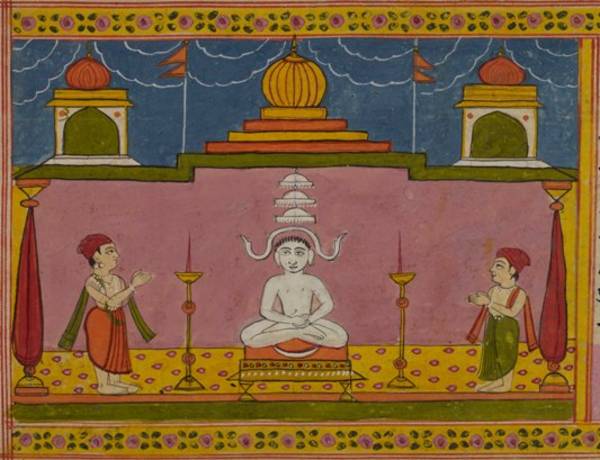
Worship of Candraprabha
Image by British Library © CC0 1.0 (Creative Commons Public Domain)
Each Jina has standard biographical information found in various sources.
Among the earliest Śvetāmbara canonical sources that provide biodata of all the 24 Jinas are the final section of the fourth Anga, the Samavāyānga-sūtra, and the Āvaśyaka-niryukti. Among the earliest Digambara sources is a cosmological work, the Tiloya-paṇṇatti.
The standard Digambara biography of Candraprabha is found on pages 44 to 65 of the 1968 edition of Guṇabhadra’s Uttarapurāṇa in Sanskrit and Hindi. The standard Śvetāmbara biography is on pages 314 to 323 in volume II of Johnson’s English translation of Hemacandra’s work, Tri-ṣaṣṭi-śalākāpuruṣa-caritra.
The biographical data can be categorised in a standard manner, and includes numbers, which are significant in wider Indian culture. These standard details can also be used to identify individual Jinas in art, since they are usually depicted as stereotyped figures. Jinas are presented in either the lotus position or in the kāyotsarga pose. Both of these imply deep meditation.
Parents
The important feature of a Jina’s father is that he is a king, from the kṣatriyacaste.
A Jina’s mother has an important role because she gives birth to a future Jina, and in practice a Jina is often called ‘the son of X’. Another reason for her importance is that the names given to the various Jinas are said to originate either in pregnancy-whims or in a dream their mothers had, at least in Śvetāmbara sources. This dream is specific, and adds to the traditional auspicious dreams that foretell the birth of a child who will become a Jina. In the case of ‘Candraprabha’ – ‘Moonlight’ – it is reported in Śvetāmbara sources that his mother had a fancy to ‘drink the moon’ during pregnancy.
|
Mother |
Father |
|---|---|
|
Lakṣmaṇā |
Mahāsena |
Places
Of the five auspicious events that mark a Jina’s life – kalyāṇakas – four take place on earth and are associated with a specific village or town in the sources. Archaeological evidence often helps to identify the old names with modern places. Even when it is lacking, there is a tendency to carry out this identification process. Associating auspicious events with certain locations makes these places sacred to Jains, so that they are potential or actual pilgrimage places and temple sites.
|
Birth place |
||
|---|---|---|
|
Candrānana or Candrapurī |
Sahasrāmravana, a park outside Candrānana |
Candrapurī
Candrapurī is the same as Candrāvatī – known nowadays as Chandravati or Chandrawati – a small village on the bank of the Ganges, 3 kilometres from Kādīpur railway station and about 20 kilometres from Varanasi.
The Vividha-tīrtha-kalpa, a 14th-century work on sacred places by the Śvetāmbara monk Jinaprabha-sūri, records the town’s:
- existence
- location near Varanasi
- link with four auspicious events connected with the eighth Jina.
The Śvetāmbara temple to Candraprabha visible today dates back to 1832. Although it is built on a mound 18 metres above the River Ganges, it has been often endangered due to floods. A Digambara temple was built close to it in 1856.
Dates and numbers
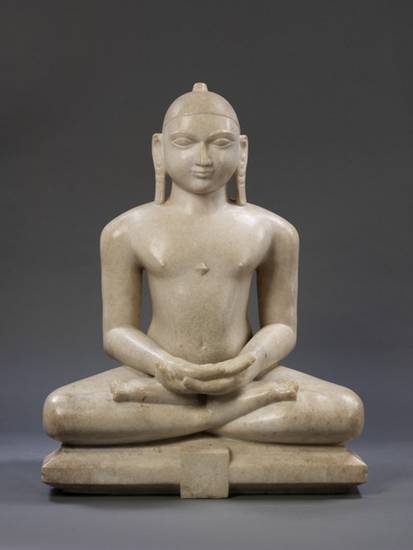
Digambara sculpture of Candraprabha
Image by Gift of Sir Michael Sadler K.C.S.I., C.B. © Victoria and Albert Museum, London
The five auspicious events that mark a Jina’s life – kalyāṇakas – are traditionally associated with a specific date. This is given according to the system of the Indian calendar:
- month
- fortnight
- day in the fortnight.
Astrological considerations also play a role here and the texts normally mention the constellations when an auspicious event takes place.
The dates associated with these events are potential or actual dates of commemoration. These may be marked in festivals, which determine the Jain religious calendar.
The birthday of Candraprabha is the occasion of an annual festival at the Śvetāmbara temple in Candravati.
|
Last incarnation |
Birth |
|||
|---|---|---|---|---|
|
5th day of the dark half of Caitra |
|
|
7th day of the dark half of Phālguna |
|
There may be variations in the dates in different sources, Śvetāmbara on one side, Digambara on the other. But there are also cases of differences within the same sectarian tradition.
There are also other numbers associated with the life of this Jina.
|
Height |
Total lifespan |
|---|---|
|
150 bows |
1,000,000 pūrvas |
Monastic and lay communities
A Jina is not an enlightened being who exists alone after reaching omniscience. After perfect knowledge comes general preaching – samavasaraṇa. This sermon, which is attended by all, is reported in the scriptures as resulting in large numbers of listeners being inspired. Many turn to religious life, becoming monks or nuns, while many others make the vows that lay people – śrāvaka and śrāvikā – can follow in their everyday lives. Further, the Jina’s teachings are preserved and passed on by his chief disciples – the gaṇadharas. This is why a Jina is also called a Tīrthaṃkara, meaning ‘ford-maker’ or ‘founder of a community’.
Each Jina establishes a ‘fourfold community‘, led by the chief disciples. Made up of monks, nuns, lay men and lay women, the fourfold community follows the principles the Jina has set out in his preaching. How members follow the religious teachings vary according to whether they remain householders or take initiation into mendicancy. Individual figures relating to each Jina are thus important.
|
Chief disciples |
Lay men |
Lay women |
||
|---|---|---|---|---|
|
93, led by Datta |
250,000 |
380,000, led by Vāruṇī |
250,000 |
410,000 |
Identification
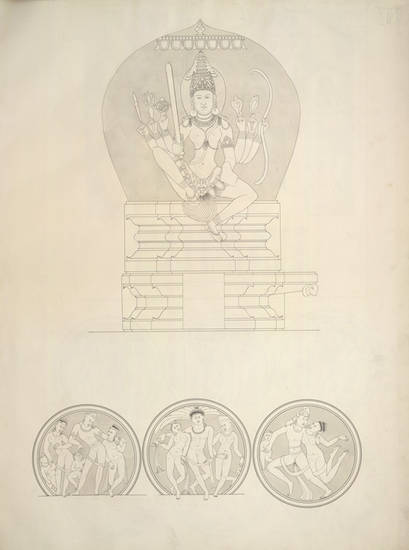
Jvālamālinī, yakṣī of Candraprabha
Image by British Library © British Library Board on www.Europeana.eu
All Jinas have individual emblems – lāñchanas – and colours that help to identify them in artwork. They also have attendant deities known as yakṣa and yakṣī, who often appear flanking them in art.
|
Colour |
Emblem |
||
|---|---|---|---|
|
‘of the moon’ – that is, white |
crescent moon |
Vijaya – Śvetāmbara |
Bhṛkuṭi – Śvetāmbara |
Jvālamālinī is one of the yakṣīs who has developed as an independent goddess among the Digambara sect, especially in south India. The legends and cult around her are rooted in Karnataka. The earliest image of her dates back to the 8th century and is found in the temple of Aihole in this region. The Jvālāmalinī-kalpa, a work representing the Jain tantric tradition, was written by Indranandi in the 10th century.
More details
Besides the basic information, the sources provide more details on various topics. These are almost infinite and vary depending on the sources. Such information differs between Śvetāmbaras and Digambaras. Here are only a few instances of extra detail.
All of the princes who become Jinas are carried to the park where they perform the ritual gesture of initiation into monastic life – dīkṣā – on a palanquin. Candraprabha’s palanquin is named Jayantī. On this occasion, he is accompanied by one thousand kings.
He performs a two-day fast. The next day he breaks his fast at the house of King Somadatta in Padmakhaṇḍapura.
Candraprabha reaches omniscience under a tree of the nāga or punnāga variety.
Events, stories and hymns
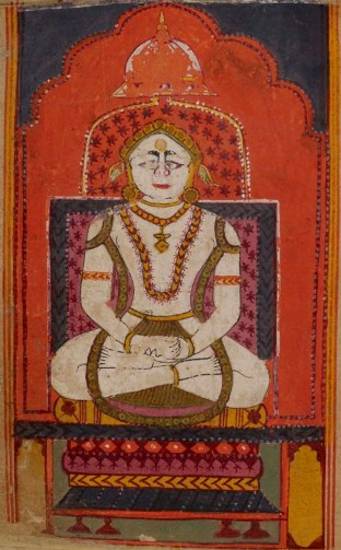
Image of Candraprabha, the eighth Jina
Image by British Library © CC0 1.0 (Creative Commons Public Domain)
The extensive body of works dealing with Jain Universal History, such as the 12th-century Tri-ṣaṣṭi-śalākāpuruṣa-caritra by Hemacandra, describe the lives of the Jinas. Except for the major Jinas, the standard Śvetāmbara biographies in such works are not fleshed out with further events or stories. This is the case with Candraprabhanātha or Lord Candraprabha.
As with other Jinas, the standard account of Candraprabha is chiefly expanded and varied in the description of his former lives. These are set in the time before his last birth, when he is reborn as a prince who is initiated and then becomes a Jina. The number of these previous births is not fully standardised.
These previous lives act as the starting point for other stories that are recounted in the biographies of this individual Jina – the Candraprabha-caritras. These are written in Sanskrit, Prakrit or in modern Indian languages from western or south India. In prose, verse or in a mixture of prose and verse, these tales are composed by Śvetāmbara as well as Digambara authors.
There is no limit to the number of such works, but a good list is given on pages 19 to 20 in Pagaria 1999. An illustrated folio from Deva-sūri’s 1207 version in Sanskrit and Prakrit is reproduced in U. P. Shah, New Documents of Jaina Painting.
Similarly, Candraprabha is praised alongside other Jinas in hymns dedicated to the 24 Jinas. One instance is the devotional song dedicated to this Jina in the Gujarati set of hymns composed by Yaśo-vijaya in the 17th century. This example can be found among the manuscripts digitised on JAINpedia.
There are also several individual hymns dedicated to Candraprabha in all Indian languages. His moonlight complexion, which appropriately evokes serenity, seems to have made him distinct, as he shares this feature only with the ninth Jina.
Temples and images
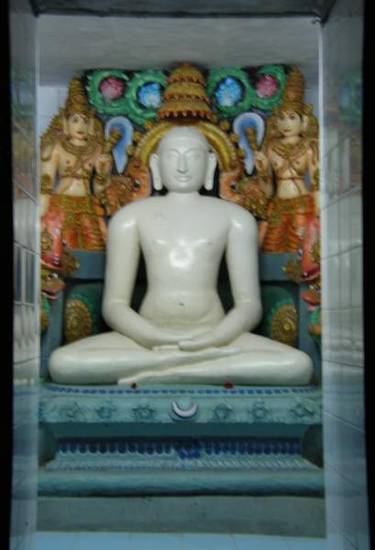
Image of Candraprabha
Image by Karine Ladrech © French Institute of Pondicherry
Sculpted images of Candraprabha are available from at least the 4th to 5th centuries CE in north India though they can be found in all areas of the subcontinent (Shah 1987: 142–144 gives several examples). The oldest available image from this period was installed by Mahārājādhirāja Gupta. The Jina is identified by name in the inscription, but no emblem is shown (Shah 1987: 142).
Among the temples to Candraprabha mentioned in medieval literary sources is the one in Somanātha-Pāṭan in Saurāṣṭra. The 14th-century Vividha-tīrtha-kalpa, Jinaprabha-sūri’s work on sacred places, also includes it. The same author also describes or narrates episodes relating to specific Candraprabha images.
An image of a Jina can be identified as Candraprabha if at least one of his two distinctive marks is shown:
- the crescent moon
- his white complexion.
Examples of depictions of Candraprabha in visual art are provided throughout this article and in the Related links.
Reading
- Uttarapurāṇa
Guṇabhadra - edited by Pannalala Jain
Jñānapītha Mūrtidevī Jaina series; volume 14
Bhāratīya Jñānapīṭha Prakāśana; Delhi and Varanasi, Uttar Pradesh, India ; 1968
- Jaina Temple Architecture in India: The Development of a Distinct Language in Space and Ritual
Julia A. B. Hegewald - Monographien zur Indischen Archäologie, Kunst und Philologie series; volume 19
Stiftung Ernst Waldschmidt, G+H Verlag; Berlin, Germany; 2009
- Vividhatīrthakalpa
Jinaprabhasūri - edited by Muni Jinavijaya
Singhi Jain series; volume 10
Shantiniketan; Bombay, India; 1934
- Śrī Candappahasāmi-cariyaṃ
Jasadevasūri - edited by Pt Rupendrakumara Pagaria
L. D. series; volume 122
L. D. Institute of Indology; Ahmedabad, Gujarat, India; 1999
- Historical Dictionary of Jainism
Kristi L. Wiley - Historical Dictionaries of Religions, Philosophies, and Movements series; series editor Jon Woronoff; volume 53
Scarecrow Press; Maryland, USA; 2004
Links
- Candraprabha and spiritual attendants
-
Pictures 16 and 17 on this page show a Digambara statue of the eighth Jina, Candraprabha, and his yakṣa and yakṣī. The sculpture comes from eastern India and dates back to the tenth century.
The HereNow4U website provides text and pictures from Gerd Mevissen's lecture, 'North Bengal (Ancient Varendra): An Innovative Sub-Centre of Jaina Sculptural Art'. This was delivered on 7 March 2008 at the tenth Jaina Studies Workshop, on the theme of Jaina Art and Architecture, held at SOAS in London.
- Praise of the Jinas
-
This 2010 YouTube video features a rendition of a hymn to the Jinas, sung in Gujarati. A stuti is an old prayer, usually in Prakrit or Apabhraṁśa, that can be either chanted or recited.
- Temples at Chandrapuri
-
Information about the temples dedicated to Candraprabha in Chandrapuri in Uttar Pradesh is available on Jinalaya.com. The Śvetāmbara temple was built in 1832 while the Digambara temple was completed in 1856. The town is closely associated with the eighth Jina, who experienced four of his five auspicious events – pañca-kalyāṇaka – there.
- +
- aAbhavya
- aAbhinandana
- aAbhiṣeka
- aĀcāra
- aĀcārāṅga-sūtra
- aĀcārya
- aAchalbhrata
- aAḍhāī-dvīpa
- aAdharma
- aAdho-loka
- aAdhyayana
- aAdvaita Vedānta
- aĀgama
- aAghātīya
- aAghātīya-karman
- aAgnibhuti
- aAgra
- aĀhāra
- aAhiṃsā
- aAhimsa Day
- aAjita
- aAjīva
- aAkampit
- aĀkāśa
- aAkbar the Great
- aAkṣaya-tṛtīyā
- aAlauddin Khalji
- aAlbert Einstein
- aAllah
- aAlms
- aĀlocanā
- aAloka-ākāśa
- aAmāri
- aAmbikā or Kūṣmāṇḍinī
- aAnagāra
- aAnanta
- aAnarthadaṇḍa
- aAnaśana
- aAnekānta-vāda
- aAṅga
- aAniconism
- aAnojjā
- aAntarāla
- aAntarāya-karma
- aAṇu
- aAṇu-vrata
- aAnukampā
- aAnuprekṣā
- aAnusvāra
- aApabhraṃśa
- aAparigraha
- aAra
- aĀrambha
- aĀrambhaja
- aĀratī
- aArdhamāgadhī Prākrit
- aArhaṃ
- aArhat
- aArśana-āvaraṇīya-karma
- aĀrta-dhyāna
- aĀryikā
- aĀryikā Jñānamati
- aĀśātanā
- aĀścarya
- aAscetic
- aAsceticism
- aAshram
- aAspiration
- aĀsrava
- aAṣṭa-maṅgala
- aAṣṭāpada
- aAstikāya
- aAstrolabe
- aAsura
- aAtheism
- aAticāra
- aAtiśayakṣetra
- aAtithisaṃvibhāgavrata
- aĀtma-vāda
- aĀtman
- aAuṃ
- aAurangzeb
- aAuspicious
- aAusterity
- aAvadhāna
- aAvadhi-jñāna
- aĀvaraṇī-yakarman
- aAvasarpiṇī
- aAvatāra
- aAvidyā
- aAxiom
- aĀyāga-paṭa
- aĀyambil
- aĀyu-karma
- aĀyurveda
- bBabur
- bBāhubali
- bBaladeva
- bBālāvabodha
- bBandha
- bBasadi
- bBazaar
- bBhadrankarvijay
- bBhagavant
- bBhaktāmara-stotra
- bBhakti
- bBhale
- bBharata
- bBhāṣā
- bBhāṣya
- bBhaṭṭāraka
- bBhāva
- bBhāva-pūjā
- bBhāvanā
- bBhavana-vāsin
- bBhavya
- bBhavyatva
- bBhaya
- bBhoga-bhūmi
- bBhogopabhoga
- bBodhi
- bBollywood
- bBrahmā
- bBrahma-deva
- bBrahmacārī
- bBrāhmaṇa
- bBraj Bhāṣā
- bBright fortnight
- bBritish Raj
- bBuddha
- bBuddhi-sagar
- bBuddhism
- bBuddhist
- cCaitya
- cCaityavāsin
- cCakravartin
- cCakreśvarī
- cCāmara
- cCandanā
- cCandragupta
- cCandraprabha
- cCanon
- cCāritra
- cCāritramohanīya-karman
- cCarũrī
- cCaste
- cCaturvidha-saṅgha
- cCaturviṃśati-stava
- cCāturyāma
- cCE
- cCelibacy
- cCha
- cChadmastha
- cChastity
- cCheda-sūtra
- cChristian
- cChristianity
- cClergy
- cCloning
- cColophon
- cCommentary
- cConch
- cConfession
- cCongregation
- cConsecration
- cCosmology
- cCremation
- cCrore
- cCult
- cCūrṇi
- dDādā-guru
- dDalit
- dDāna
- dDaṇḍa
- dDark fortnight
- dDarśana
- dDarśanamohanī-yakarman
- dDaśa-lakṣaṇa-parvan
- dDeity
- dDelhi Sultanate
- dDerāsar
- dDeśāvakāśika-vrata
- dDetachment
- dDevanāgarī
- dDevānandā
- dDevarddhi-gani
- dDevotee
- dDhamal
- dDhanuṣ
- dDhāra
- dDharma
- dDharma-dhyāna
- dDharma-sāgara
- dDharmastikaya
- dDhātakīkhaṇḍa
- dDholak
- dDhyāna
- dDiaspora
- dDig-vrata
- dDigambara
- dDīkṣā
- dDisciple
- dDīvālī
- dDivya-dhvani
- dDNA
- dDoctrine
- dDogma
- dDonor
- dDoṣa
- dDravya
- dDravya-pūjā
- dDrone
- dDuṣamā
- dDuṣamā-duṣamā
- dDuṣamā-suṣamā
- dDveṣa
- dDvīpa
- eEast India Company
- eEightfold Path
- eEkānta-vāda
- eEkendriya
- eElder
- eElders
- eEschatology
- eEtc up to
- fFarmān
- fFast
- fFatehpur Sikri
- fFestival
- fFestschrift
- fFiruz Shah
- fFly-Whisks
- fFolio
- fFour Noble Truths
- gGaccha
- gGaṇa
- gGaṇadhara
- gGanadharavada
- gGaṇeśa
- gGaṇin
- gGarba
- gGarbha
- gGarbha-gṛha
- gGaruḍa
- gGati
- gGene
- gGenomics
- gGhātī-yakarman
- gGhātīya
- gGhaznavid
- gGhiyasuddin Tughlaq
- gGhurid
- gGloss
- gGotra-karma
- gGujarāt
- gGujarati
- gGuṇa
- gGuṇa-sthāna
- gGuṇa-vrata
- gGupti
- gGuru
- gGuruṇī
- hHagiography
- hHajj
- hHaṃsa
- hHaribhadra
- hHariṇaigameṣin
- hHasta
- hHeresy
- hHiṃsā
- hHindi
- hHindu
- hHinduism
- hHīravijaya
- hHoroscope
- hHrīṃ
- hHumayun
- hHymn
- iIconoclasm
- iIconography
- iIdol
- iIndian Independence
- iIndology
- iIndra
- iIndrabhūti Gautama
- iIndriya
- iInitiation
- iIntercession
- iInvocation
- iIQ
- iIslam
- iIslamicate
- iIṣṭadevatā
- iĪśvara
- jJagat
- jJahangir
- jJain
- jJaina Devanāgarī
- jJaina Śaurasenī
- jJaina-dharma
- jJainaśāsana
- jJainness
- jJaisalmer
- jJamāli
- jJambū-dvīpa
- jJames Burgess
- jJanma
- jJanma-kalyāṇa
- jJarā
- jJāti
- jJina
- jJina-āgama
- jJina-bhavana
- jJina-bimba
- jJina-mātā
- jJinacandra-sūri
- jJinadatta
- jJinaprabha
- jJīva
- jJñāna
- jJñāna-āvaraṇīya-karma
- jJñāna-āvarṇiya
- jJñānsundar
- jJyotiṣka
- kKāla
- kKālakācārya-kathā
- kKālidāsa
- kKalpa-sūtra
- kKalpa-vṛkṣa
- kKalyāṇaka
- kKalyanvijay
- kKamaṇḍalu
- kKamaṭha
- kKarma
- kKarma-bhūmi
- kKarma-grantha
- kKarma-prakṛti
- kKarma-vāda
- kKarmon
- kKarnataka
- kKaṣāya
- kKathā
- kKāvya
- kKāya
- kKāyotsarga
- kKeśa-loca
- kKetu
- kKevala-jñāna
- kKevalin
- kKhalji
- kKharatara-gaccha
- kKnowledge
- kKriyā
- kKriyā-vāda
- kKṛṣṇa
- kKṣamā-śramaṇa
- kKṣapakaśreṇi
- kKṣatriya
- kKṣullaka
- kKulakara
- kKundakunda
- kKunthu
- lLabdhi
- lLaity
- lLakh
- lLāñchana
- lLands of Action
- lLaukāntika
- lLavaṇa-samudra
- lLeśyā
- lLiṅga
- lLinguistics
- lLoka
- lLoka-ākāśa
- lLoka-puruṣa
- lLoka-vāda
- lLotus
- lLotus lake
- mMadhya-loka
- mMahā-videha
- mMahā-vrata
- mMahābhārata
- mMahāmastakābhiṣeka
- mMāhārāṣṭra
- mMāhārāṣṭrī Prākrit
- mMahattarā Yākinī
- mMahāvīr Jayantī
- mMahāvīra
- mMakāra
- mMakkhali Gośāla
- mMalli
- mMāna-stambha
- mManaḥ-paryāya-jñāna
- mMaṇḍala
- mMaṇḍapa
- mMandit
- mMaṅgala
- mMantra
- mMantras
- mManuṣya-loka
- mMarāṭhī
- mMārgaṇā
- mMartyr
- mMarudevī
- mMaṭha
- mMati-jñāna
- mMauryaputra
- mMecca
- mMendicant lineage
- mMetarya
- mMiracle
- mMithyādṛṣṭi
- mMohandas Gandhi
- mMohanīya-karma
- mMokṣa
- mMonastic order
- mMonasticism
- mMonk
- mMonotheism
- mMosque
- mMount Meru
- mMount Sammeta
- mMṛgāvatī
- mMughal
- mMuhammad
- mMuhammad bin Tughlaq
- mMuhpattī
- mMūla-sūtra
- mMūlaguṇa
- mMumbaī
- mMuni
- mMunisuvrata
- mMurad Bakhsh
- mMūrti-pūjaka
- mMuslim
- mMysticism
- nNābhi
- nNāga-kal
- nNāgapurīya Tapā-gaccha
- nNāgarī
- nNāma-karma
- nNamaskāra-mantra
- nNami
- nNandīśvara-dvīpa
- nNandivardhana
- nNandyāvarta
- nNāraka
- nNāraki
- nNasalisation
- nNātha
- nNavrātrī
- nNaya-vāda
- nNemi
- nNidāna
- nniggaṃthāṇa vā 2
- nniggaṃtho vā 2
- nNigoda
- nNihnava
- nNikṣepa
- nNirgrantha
- nNirjarā
- nNirvāṇa
- nNiryukti
- nNiṣidhi
- nNitya
- nNiyati
- nNo-kaṣāya
- nNudity
- nNun
- oOcean of milk
- oOmniscience
- oOrdination
- ppa°
- pPadmaprabha
- pPadmāsana
- pPadmāvatī
- pPādukā
- pPalanquin
- pPalette
- pPañca-muṣṭi
- pPāṇḍava
- pPaṇḍit
- pPandit Dalsukh D. Malvania
- pPandit Sukhlalji
- pPāṇipātra
- pPāpa
- pParamātman
- pParameṣṭhin
- pPāraṇā
- pParigraha
- pPariṇāma
- pParīṣaha
- pParokṣa
- pPārśva
- pPārśvanātha
- pParyāya
- pParyuṣaṇ
- pPaṭa
- pPatan
- pPātra
- pPenance
- pPersian
- pPhala
- pPhilology
- pPicchikā
- pPilgrimage
- pPīr
- pPolymath
- pPoṣadha
- pPossession
- pPothī
- pPrabhas
- pPradakṣiṇā
- pPradeśa
- pPrākāra
- pPrakīrṇaka-sūtra
- pPrākrit
- pPramāda
- pPramukhā
- pPrati-vāsudeva
- pPratikramaṇa
- pPratimā
- pPratiṣṭhā
- pPratyākhyāna
- pPratyakṣa
- pPravacana
- pPrāyaścitta
- pPrayer
- pPre-modern
- pPreach
- pPredestination
- pProtestant
- pProvenance
- pPudgala
- pPūjā
- pPujārī
- pPukharavara-dvīpa
- pPuṇya
- pPūrva
- pPuṣkara-dvīpa
- pPuṣpadanta
- pPyre
- qQur’an
- rRāga
- rRāhu
- rRainy season
- rRajasthan
- rRajasthani
- rRājimatī
- rRajoharaṇa
- rRajput
- rRāma
- rRāmāyaṇa
- rRangoli
- rRās-garbā
- rRasa
- rRathanemi
- rRatna-traya
- rRātri-bhojana
- rRaudra-dhyāna
- rRecto
- rRelic
- rRenunciation
- rRetroflex
- rRevatī
- %Ṛg-veda
- rRite
- rRosary
- %Ṛṣabha
- %Ṛṣabhanātha
- rRupee
- sSaciyā Mātā
- sSādhu
- sSādhvī
- sSāgāra
- sSaint
- sŚaivaism
- sŚaka-saṃvat
- sSallekhanā
- sŚalya
- sSamacatuṣṭha
- sSamādhimaraṇa
- sSamaṇi
- sSāmarambha
- sSamavasaraṇa
- sSāmāyika
- sSaṃbhava
- sSamiti
- sSaṃjñā
- sSaṃkalpaja
- sSaṃsāra
- sSamudghāta
- sSaṃvara
- sSaṃvega
- sSamyak-cāritra
- sSamyak-darśana
- sSamyak-jñāna
- sSamyaktva
- sSaṃyama
- sSanctuary
- sSandalwood
- sSaṇgha
- sSanskrit
- sSant
- sŚānti
- sSapta-bhaṅgi-naya
- sSārambha
- sSarasvatī
- sSarvajña
- sSāsan-devi
- sŚāsana-devatā
- sŚāstra
- %Ṣaṭ-jīvanikāya
- sSatī
- sSatīmātā
- sSatya
- sSchism
- sScribe
- sScripture
- sSect
- sSecularism
- sŚenāī
- sSermon
- sŚeṣavatī
- sSevā
- sSeven fields of donation
- sShah Jahan
- sShantidas Jhaveri
- sShrine
- sSiddha
- sSiddha-śilā
- sSiddhacakra or Navadevatā
- sSiddhānta
- sSiddhārtha
- sSiddhi
- sSikh
- sSikhism
- sŚikṣā-vrata
- sŚīla
- sSin
- sSindh
- sŚītala
- sŚiva
- sSkandha
- sSomanatha
- sŚraddhā
- sŚramaṇa
- sŚrāvaka
- sŚrāvakācāra
- sŚrāvikā
- sŚreyāṃsa
- sŚrī
- sŚrīvatsa
- sŚruta-jñāna
- sŚruta-pañcamī
- sSthānaka-vāsin
- sSthāpanācārya
- sSthāvara
- sSthavira
- sSthiti
- sStrīmukti
- sStūpa
- sSubcontinent
- sSudarshana
- sŚuddhi
- sSudharma
- sŚūdra
- sSufism
- sSukha
- sŚukla-dhyāna
- sSulasā
- sSultan
- sSumati
- sSundarśrī
- sSupārśva
- sSūri
- sSuṣamā
- sSuṣamā-duṣamā
- sSuṣamā-suṣamā
- sSūtra
- sSuyam me ausam! Tenam bhagavaya evamakkhayam
- sSvādhyāya
- sSvāhā
- sSvastika
- sŚvetāmbara
- sŚvetāmbara Terāpanthin
- sŚvetāmbaras
- sSwan
- sSyād-vāda
- tTabla
- tTantra
- tTapā-gaccha
- tTapas
- tTāraṇ Svāmī Panth
- tTattva
- tTattvārtha-sūtra
- tTemple
- tTemple-city
- tThe Enlightenment
- tTheology
- tThree worlds
- %Ṭīkā
- tTilaka
- tTīrtha
- tTīrthaṃkaranāma-karman
- tTīrthankara
- tTransliteration
- tTrasa
- tTrasa-nāḍī
- tTriśalā
- tTriṣaṣṭi-śalākā-puruṣa-caritra
- tTti bemi
- tTughlaq
- tTunk
- uUdumbara
- uUniversal History
- uUpādhyāya
- uUpāṅga
- uUpaniṣads
- uUpāsaka
- uUpasarga
- uUpāśraya
- uŪrdhva-loka
- uUtsarpiṇī
- uUttarādhyayana-sūtra
- vVāhana
- vVaimānika
- vVairāgya
- vVaiṣṇava
- vVaiśramaṇa
- vVaiśya
- vValabhī
- vVanaspatikāya
- vVandana
- vVaṇik
- vVarṇa
- vVāsudeva
- vVāsupūjya
- vVayubhūti
- vVeda
- vVedanīya-karma
- vVegetarianism
- vVehicle
- vVernacular
- vVerso
- vVidyā
- vVidyā-devī
- vVihāra
- vVijñapti-patra
- vVikrama-saṃvat
- vVikṛti
- vVimala
- vVinaya
- vVipāka
- vVirji Vora
- vVirodhaja
- vVīrya
- vVisarga
- vViṣṇu
- vVītarāga
- vVizier
- vVotive
- vVow
- vVrata
- vVS
- vVyakta
- vVyantara
- vVyasana
- yYakṣa
- yYakṣī
- yYantra
- yYaśoda
- yYaśovijaya
- yYati
- yYātrā
- yYoga
- yYoginī
- yYojana







